Hi Guys. The Board Kane made is mine. It goes great, especially compared to regular balsa deck. I got it Friday, surfed it once, then opted to ride it in a serious contest on Saturday over all my other boards. The actual shape is flat/thick.deep single which normally wouldnt flex much anyway, so it was actually stiif but still good. It was completely done in RR Kwick Kick, so next Kane said he will opt for a flexier formula 2000, or 2020 to lam the board together, then filler in KK. It has a tiny amount of heel/toe dent which you need for a board to go and feel magic. Kane has done me boards in all kinds of crazy tech, but this is the first one I chose to put to the test in a contest. it won me plenty of heats so I was stoked! Kane is setting up a sick new epoxy lab in my new factory, and since we are the distributers for Resin Research here in OZ, expect some wicked things in the very near future. Ill post up some shots of the board after its had aother good bashing too. Cheers Drew for hookin Kane up, Im amping for the next one. Polsy
toby wrote:
"Because the cork is impermeable? So no glue can soak into it?"
Cork has spaces between the grains, similar to foam having spaces between the beads or bubbles...Those spaces allow the resin to "key" into them....
When I taught a workshop in France, I went to a cork manufacturer...Fascinating to a cork geek like me...
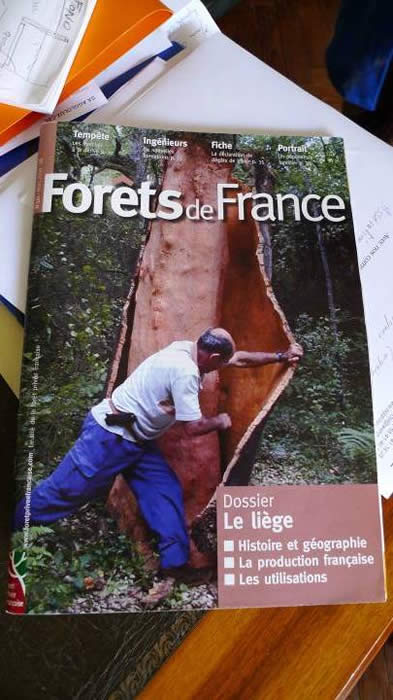
(above) Next on our list of things to get: cork for the rails of the boards we will build in the workshop…We stopped in at Aggloloux-CBL one of the two cork ‘factories’ in France, and was given a guided tour by the grandson of the man who founded the company in 1923…
In this magazine cover, it shows a cork harvester cutting the bark from a cork oak tree…The trees have been harvested this way forever, and the bark grows back and is re-harvested every five to seven years…Sustainable resource management, in the best possible way…
**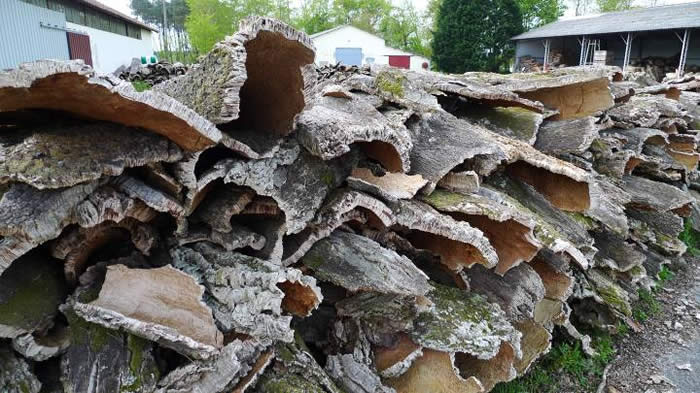 **
**
(above) Here is the raw cork bark drying out…
**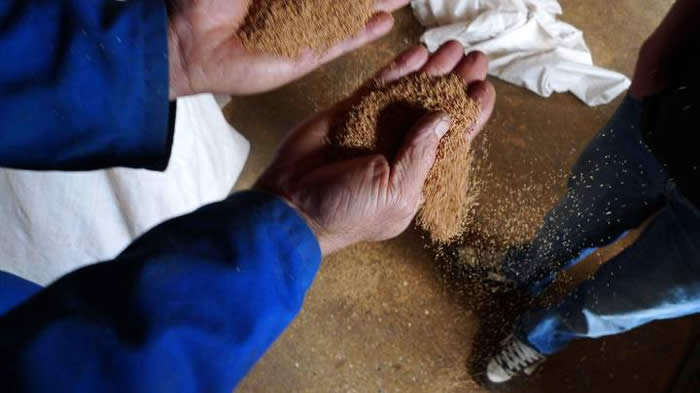 **
**
(above) One of the ways the cork is used is to grind it up, liquid binders are added, stirred, put it in a mold, add heat and pressure then let it cook…Here two different densities of grind are compared…The binders are formulated depending on the desired finished product...The possibilities are endless...I'm still waiting for someone to use cork in a wetsuit...It can be done...
**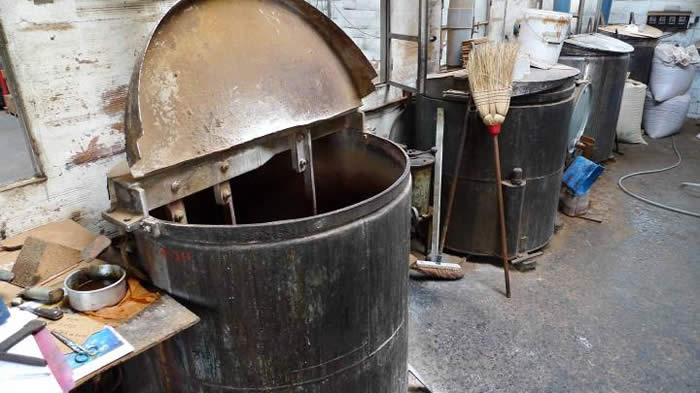 **
**
(above) These are the decades old, still state of the art mixing machines…
** **
**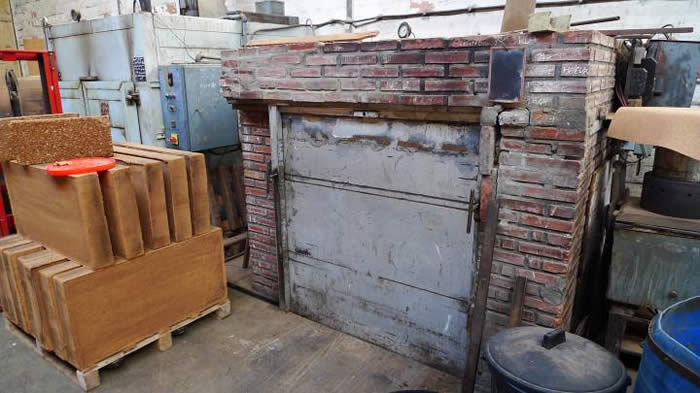 **
**
(above) After the mixture is put in a mold, they are put under pressure then placed in this oven to cook..
**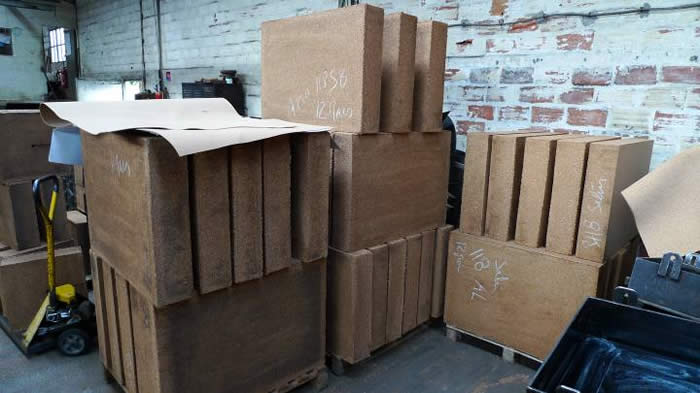 **
**
(above) Out of the oven come these loaves…Other molds produce cylinders…
**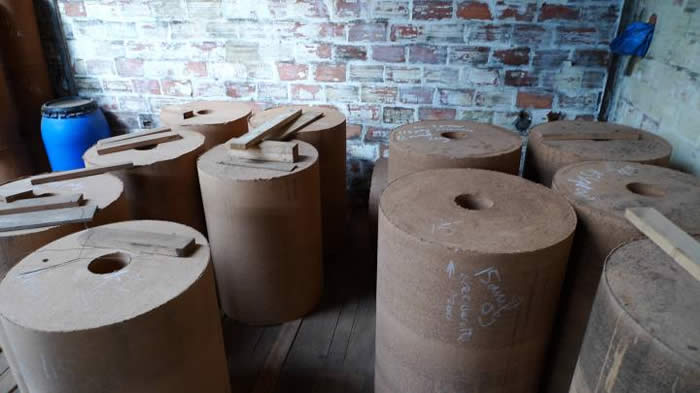 **
**
(above) Some solid cork cylinders ready for the next phase…
**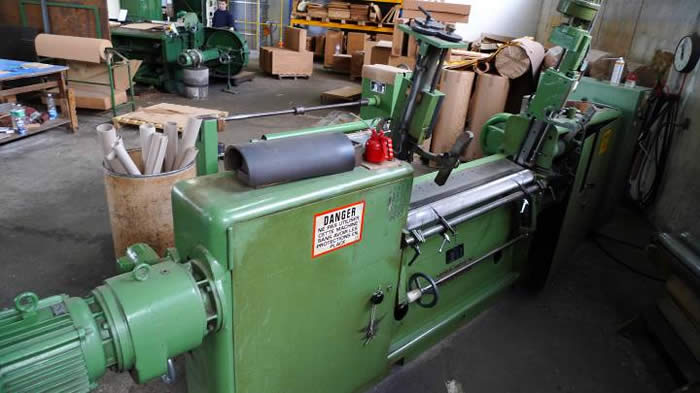 **
**
(above) The lath which “peels” the cork from the roll…
**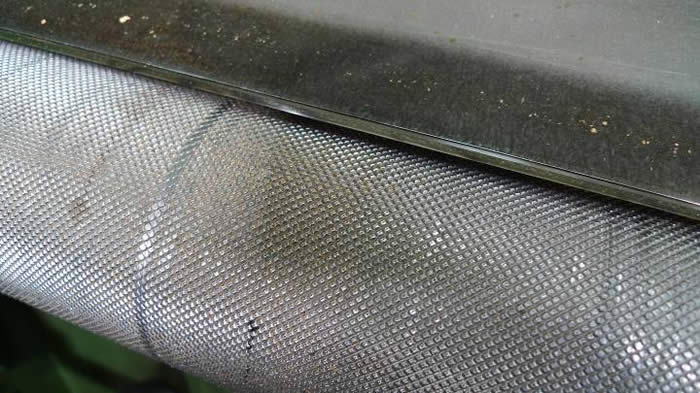 **
**
(above) just above the toothed roller is the blade…
**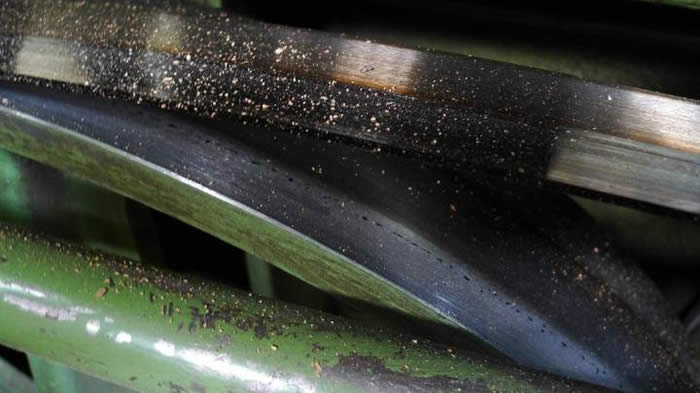 **
**
**(above) The blade…twice as sharp as any razor blade you’ll ever see…**
**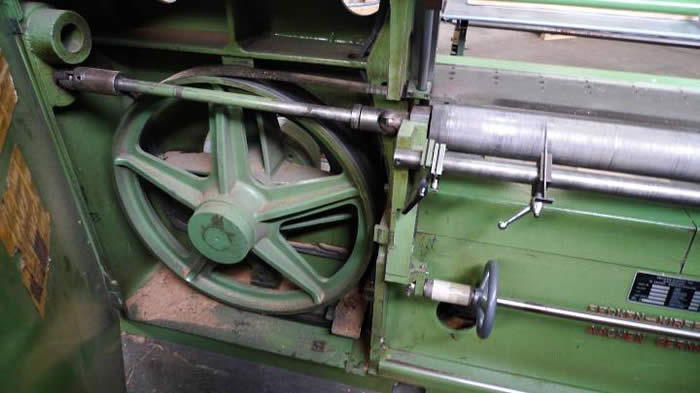 **
**
(above) It is in the form of a continuous blade that is just like a bandsaw…The cylinder of cork is set onto a roller then the machine starts, the belt rotates and the cylinder is rotated and “peeled” the same way that logs are peeled of their veneers…
**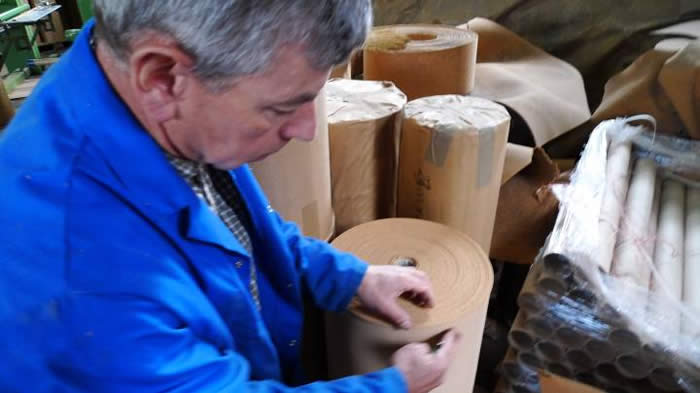 **
**
(above) Here monsieur Cave Bernard the grandson of the founder, shows a roll of peeled cork…
**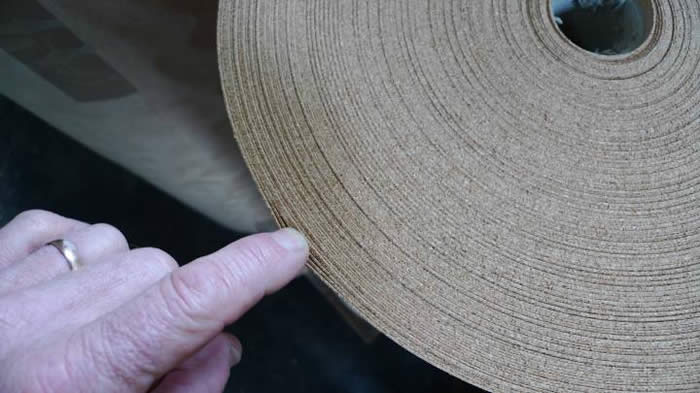 **
**
(above) That is how thin they can peel it… We will use some sheets that are thicker…
**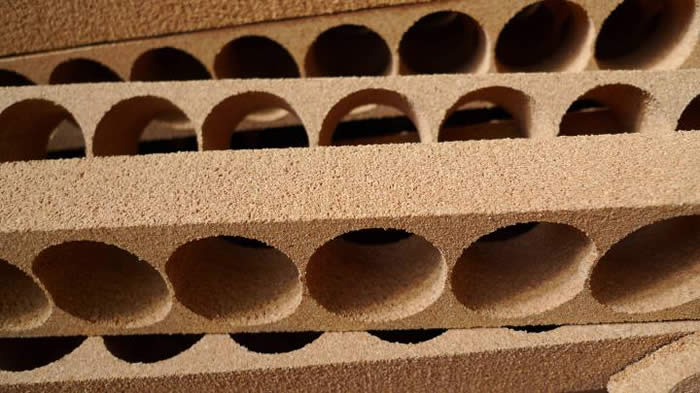 **
**
**(above) From these…**
**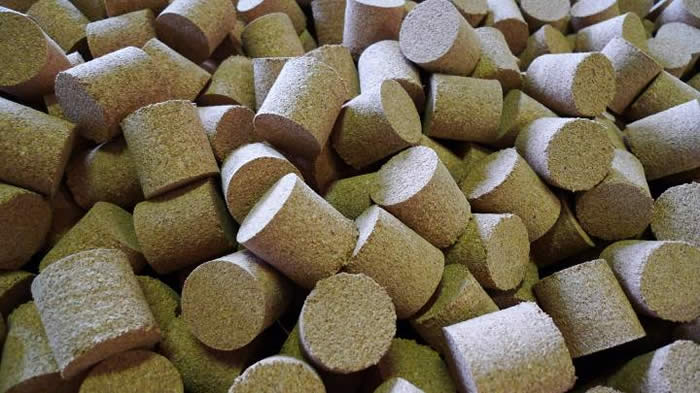 **
**
(above) …come these…
**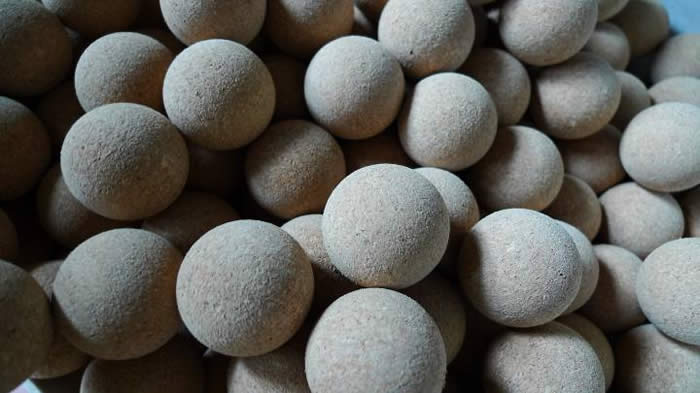 **
**
(above) …and turn them into these…
**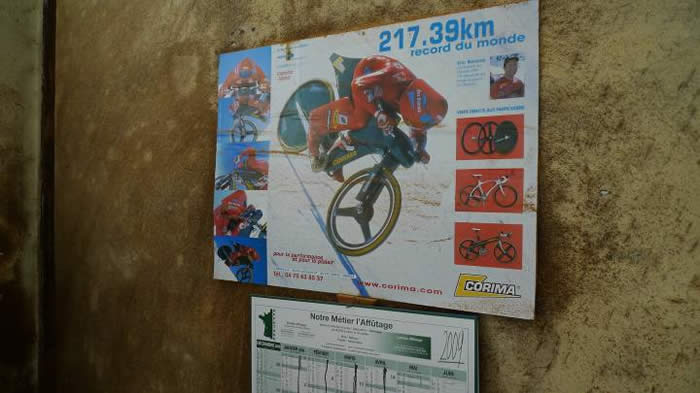 **
**
(above) Yes, there is a connection here…
**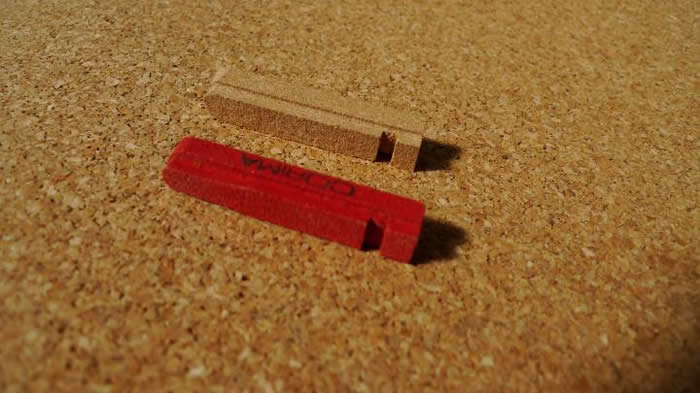 **
**
(above) Cork brake shoes for bikes…
**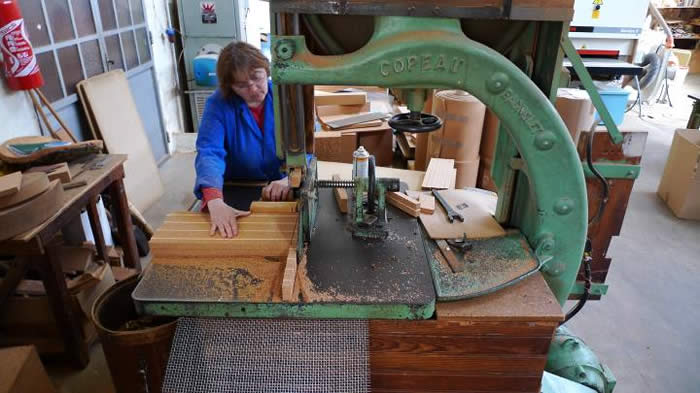 **
**
(above) It’s done the same way as it has for decade, real people in a family business doing something they believe in…
**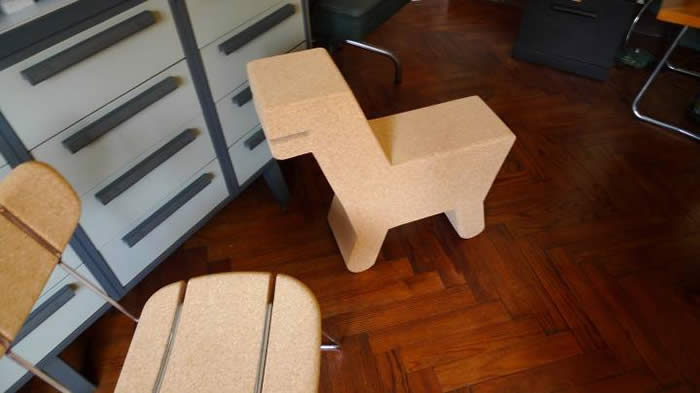 **
**
(above) The chair in the foreground is a new product…It folds flat and has a reinforced cork seat and backrest…The other thing is a prototype play horse for children…
**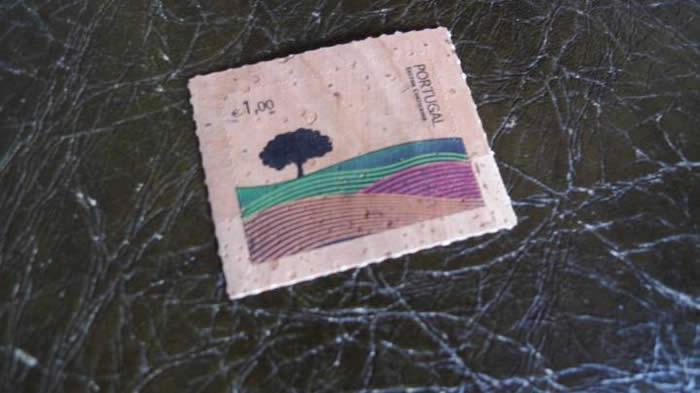 **
**
(above) Portugal made a series of stamps using paper thin cork…
**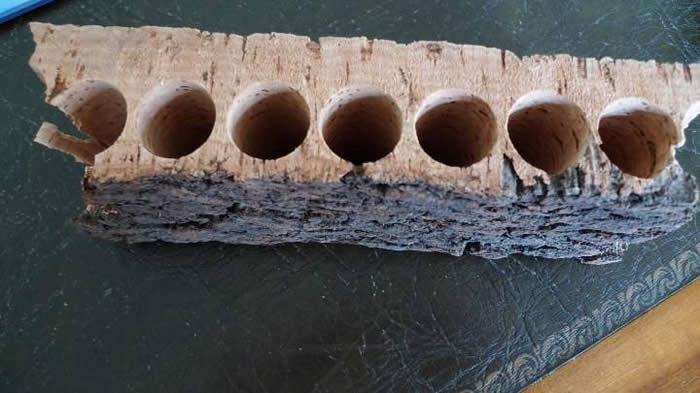 **
**
(above) the older harvests of cork are more valuable and used to cut the stoppers for wine bottles…
** **
**
(above) Call me nostalgic of the older ways and I know I am more than a bit of a cork geek, but guys like this, Cave’s father, are a vanishing breed we need to honor their commitment to products they are passionate about…
**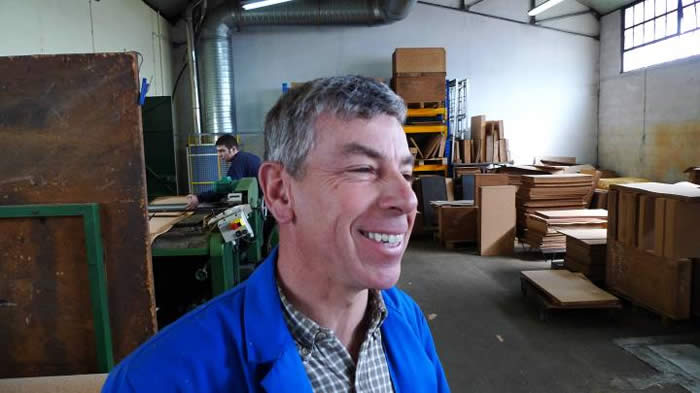 **
**
(above) the tradition lives on… Visit and support generational families like these… More at: , www.agglolux-cbl.com
Great images Paul.
What if you vac bag it in the usual two-step process? Doing the first side the resin will suck into and through the gaps (all the way through the cork?), leaving no more gaps for the resin from the other side to key into later?
Does it work OK for hand lams, or best vacuumed?
Great stuff Paul.
Keying represents a mechanical bond of course. That in itself doesn’t sway me if the keying effect is substantial enough to lock the two together. I suspect it will be adequate.
I don’t have a vac bagging set up but the sheets are thin enough not to dissuade me from trying a hand lay up. If I lay out the sheet with a systematic method of good tape that can be adhered as I wetout and roll it intoplace. It may not even require that much diligence.
I’m keen to get rail protection on EPS cores. Greater density in that area in place of the weight of a centerline stringer could be the route to go. Obviously your method of construction is a different animal altogether than the more conventional production line I envision.
It would be interesting to compare a balsa parabolic to a cork parabolic product. Balsa has terrific compressioncharacteristics but avoiding water absorption isn’t its strongest feature. That is unless someone like Bert is using a different genus of readily available balsa found in his neck of the woods (pun intended).
P.S. As far as the heat thing, not much worrry to me when I do a white opaque over the entire board.I’m into the function not the current fashion.
Cork is cool stuff. I prefer it in the soles of my shoes (Birk's or Haflingers) and handles for bikes, ski poles, etc., and thought it might have broader possibilities. Has anyone here posted, or know, what is the binder material used when creating solid cork from the ground-up bits?
From a cork website:
So what is cork? Cork is actually the outer bark of a tree, Quercus suber, which grows in the Mediterranean. Cork oak forests cover approximately 5.4 million acres amongst the seven primary cork producing countries; (30% Portugal, 21% in Algeria, 20% in Spain, 16% in Morocco, 5% in France and 4% each in Italy and Tunisia). Cork forests are carefully managed and treasured in particular by Portugal, which produces 50% of the worlds cork supply.
Cork bark is typically harvested every nine or ten years. After the slabs of cork bark are harvested they are cleaned, boiled and stripped of the rough outer surface. Bottle stopper "corks" are then punched from the best material in the slabs. The remaining scraps are then ground into small granules, mixed with a binder, molded into large blocks and baked in specialized ovens - making use of every scrap of cork bark.
Corks remarkable properties are derived from its cellular structure of hollow, polyhedral (14 sided) cells with extremely strong yet flexible cell walls that are waterproof and airtight. Joined together in a honeycomb like fashion, cork cells produce a very low-density, compressible insulating material.
Composition cork consists of binder that is typically the natural resins in cork, phenolic resins, protein, or other special polymeric binders. These binders coat each particle of cork and are joined together under pressure to form a solid mass. The form of this mass may be either in block form that is then cut into sheet material or in log form to produce continuous rolls.
Cork/rubber composition involves the introduction of rubber into the cork composition. This can also be molded into blocks for sheeting or pressed into continuous roll forms. Of the composition cork materials already described, those combinations containing phenolic resin or protein binder systems are the least expensive, followed in increasing order by special polymeric systems and cork and rubber combinations.
…hello Drewtang, thanks for your response.
Yes, somewhat new so still my question will have a bit more time to answering right.
but Im very interested in these types of building-glassing techniques.
sadly, you dont find RR everywhere as brands of polyester resins.
I'm new to this site and haven't read all the background, so bear with me. Does anyone know of research and application of cork as a structural material? Based on my limited knowledge of other composite materials I assume that strength (probably tensile and possibly compression) is enhanced by a mix of aggregate size and the introduction of linear elements (fibers). Assuming that folks are interested in cork, at least partially, for it's organic qualities, it's appealing to think that adding an organic fiber would promote qualities that broaden the applications. Fibers don't necessarily need to be very long or strictly oriented to yield benefits.
[quote="$1"]
I'm new to this site and haven't read all the background, so bear with me. Does anyone know of research and application of cork as a structural material? Based on my limited knowledge of other composite materials I assume that strength (probably tensile and possibly compression) is enhanced by a mix of aggregate size and the introduction of linear elements (fibers). Assuming that folks are interested in cork, at least partially, for it's organic qualities, it's appealing to think that adding an organic fiber would promote qualities that broaden the applications. Fibers don't necessarily need to be very long or strictly oriented to yield benefits.
[/quote]
It appears to have some resiliency as a core material. Structurally, it seems like it would be as good as a high density foam sheet. As for fibers, Drew's putting them above and below the cork, so if it only brings compression strength to the composite, it seems to have plenty of breakage/compressive strength from the glass.
Yeah, I reckon that much of the strength in this application comes from the glass job. I was thinking more of how the cork itself might be engineered to be more structural, as, say a dent resistant deck or possibly stringers. I'm guessing that cork is UV resistant and used as a skin could be an elegant alternative to ozone depleting UV additives in standard blanks.
I messed up my cherry skins, the up side is it worked as a peel test. The eps bond was so-so, the ply bonded well and the cork was a pain to get it up.
The cork bond was the strongest by far.
I am a flooring contractor by trade and cork is also the hardest floor to remove because you can bang on it with a crowbar and hammer all day and it just bounces back, dry ice does not do anything and water does not work to weaken it.
The trick will be to get the cork in the right density.
I may have to try this!!
Bummer about that board, but cool feedback. I made these Slotted twinnies today out of scrap; bamboo, cork, bamboo, cork, bamboo.
Australian people, the Amorim distributor in Australia (QLD) is
http://www.lavender-ce.com/. Simon, the guy who responds to contact inquiries, is
super helpful and has a bunch of thicknesses in stock. I’m getting some
2mm and 3mm NL-10 sheets (can also get ~30m rolls) to lay up some test panels and get a feel for it.
As the lavender-ce guy said, it might also make a nice grip pad laminated to the outside of the board.
Anyone know if it’s easy to machine? I.e. solid cork rails? I’m worried it might pull out in chunks when planed or sanded.
NL-10 is 24.6lbf or 120kg/m^3.
NL-20 is 41.0lbf or 200kg/m^3.
NL-25 is 51.2lbf or 250kg/m^3
I’ve hand laminated boards with cork rails. Did a couple with 1/2" + of just cork on the outer edge and 1/8" balsa against the foam as the perimeter stringer. Hand laminating seemed to work OK, but you have to do a little baby sitting.
I used 2 densities of cork, a larger particle piece that comes in 12" x 1/2" thick squares went closer to the balsa and a finer material that comes in rolls a little less than 1/8" thick was used on the outer side. The roll cork is easy to work with, but the 12" squares didn’t smooth out very well. I used that to build up the rails faster, but in hindsight it would have better to stick with more layers of the finer cork.
It would be interesting to see a board that uses cork as the core material. I bet you could go really thin.
My grandfather used to use cork to seal the gaps on the boats he made. Kind of nice to see it being used in boards.
I’m interested in trying to do a cork deck. I found this:
http://www.csnstores.com/3mm-or-1-8-cork-rolls-200-sq-ft-APK1098.html
It’s 3 mm. Comes in a 4’ x 50’ roll. Ends up being $81 after shipping to S.CA. Anyone interested in splitting a roll with me?
I bought a small roll of cork from Staples to put up on my wall, but it’s only 2’ x 4’. I’d like to have a roll long enough for the length of a board.
You can get the same thing on amazon for $73 after shipping from the csn store.
I would go in with you but I am in San Francisco and you may want to go thinner.
Thanks, I found the 2 mm stuff with free shipping. Small enough roll, so it’s not too expensive.
I think you might want to be careful with the cork product you pick. There’s a lot more going into this than just cork bark. A lot to fro with the binders. The corecork has been tested in several industries, there’s multiple densities and products. You might get lucky with some shit on the internet, but they are advertising it for kitchen drawer liners you know? Why don’t you just call me, 904-347-8879 , and ill send you enough for a deck?
Drew
you might want to consider the NL-20. Even though it is heavier density( I think 12ft3) it won’t suck up as much resin and comes out lighter than the NL10. If you are infusing resin the NL-20 is a must for the same reason.
I think it is a good value(core cork brand) and when making surfboards you can split the 4 ft roll in half and get a lot of boards out of the roll. The distributor in Rhode Island is very helpful. His name is Dan Brady Dan@corecomposites.com. You should be able to get a free sample enough to do a board since you are a manufacturer.
Heed Drewtang’s advice: Be very careful buying just anything on ebay regarding cork. Corecomposites know their stuff and will save you time and money because they have it wired for density needs/application and good advice overall on its usefulness for your specific situation. I don’t think I have ever seen EBAY cork with density specs only millimeter thickness. BE VERY CAREFUL if you have no density specs.
The cork looks sweet. I’v had good luck with bamboo (fibers running side to side for more flex) but find it a little brittle and extremely sensitive to the slightest water intrusion. Has anyone tried wrapping the rails with cork? Thanks for posting this drewtang.


